Genotype unit area (GUA) is defined as the area occupied by an independent unit of host tissue of the same genotype (Mundt and Browning 1985). Normally, GUA is the size of an individual plant, but not always. For example, if individual plants are intertwined in the field, then the effective GUA may be smaller. And in the case of clonally propagated plants, the GUA could be larger than the individual plant (Garrett and Mundt 1999). On an individual plant basis, crop species with a small GUA include wheat, barley, oats and rice. Those with a moderate-sized GUA include beans, potatoes, and corn, whereas fruit trees have a large GUA.
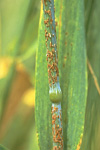 |
Uredinia of Puccinia graminis f. sp. tritici, causal agent of stem rust, on wheat. (Courtesy B. Steffenson) Click image to enlarge. |
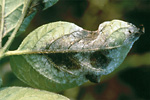 |
White sporangia and sporangiophores of Phytophthora infestans, causal agent of late blight, at the margins of necrotic potato leaf lesions. (Courtesy R.V. James) Click image to enlarge. |
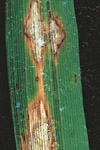 |
Mature rice blast lesions showing necrotic borders caused by Magnaporthe grisea. (Courtesy J.M. Bonman) Click image to enlarge. |
A genotype unit area that is very small is in most cases the ideal for suppression of disease. But specific combinations of genotype patterning and dispersal gradients may result in other GUA optima (Garrett and Mundt 1999). In general, as GUA increases, the effectiveness of mixtures for disease suppression decreases (Mundt 1989). GUA interacts with the dispersal gradient of the pathogen as shown in the figure below:
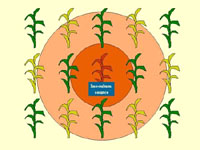 |
|
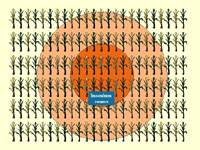 |
| Each figure depicts two pathogen propagule dispersal gradients (circles) originating from the center host plant superimposed over a mixture of two plant genotypes (as indicated by color). Within each dispersal gradient, propagule loads decrease with distance from the source. Left) When the size of individual plants is large relative to the dispersal gradient or the gradient is steep, inoculum tends to land on and reinfect the host plant on which it originated. Right) When the size of individual plant is small relative to the dispersal gradient or the gradient is shallow, a greater share of inoculum falls on plants with a genotype different from the source host plant. Click either image for an enlarged view. |
Mundt and Leonard (1986), working with bean rust, demonstrated that the least amount of disease was associated with the smallest genotype unit area. Mundt and Browning reported similar results (1985) with oat crown rust and maize common rust.
|
Effect of spatial arrangement of susceptible and resistant snap beans on the increase of bean rust in mixtures of susceptible and resistant plants and in pure stands of susceptible plants in field plots. |
|
Relative area under the disease progress curvea |
|
Genotype unit area (m²) |
1982b |
1983c |
1984c |
|
Pure line susceptible |
13.40 |
1.00 |
1.00 |
1.00 |
|
Mixture |
0.023 |
0.73 |
0.42 |
0.57 |
| |
0.093 |
0.76 |
0.29 |
0.58 |
| |
0.372 |
0.99 |
0.71 |
0.56 |
| |
0.836 |
0.90 |
1.31 |
0.72 |
a The area under the disease progress curve (ADPC) for each treatment divided by the ADPC for the pure-line susceptible treatment.
b Mixture treatments consisted of 50% susceptible plants and 50% resistant plants.
c Mixture treatments consisted of 25% susceptible and 75% resistant plants. |
